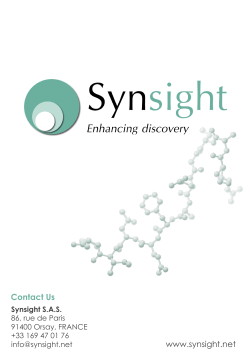
Exam 2
Chem 105 Exam 2 Name_______________________ This exam is schedule for 75 minutes and I anticipate it to take the full time allotted. You are free to leave if you finish. In multiple part problems, points awarded will not be penalized for incorrect answer on previous parts, so simply move on if you get stuck on one part. If you need to, make up an answer for the previous part. Always neatly show work for partial credit. When you draw Lewis structures ALWAYS include lone pairs and redraw them to show the correct molecular geometry! A ‘connect the dots’ structure is not complete and will not receive full credit. Show all formal charge. 1. Name each of the following compounds: MgCl2 Cu2SO4 PF6 2. Determine the correct molecular formula for each of the following compounds: Ammonium oxide iron (III) carbonate tricarbon tetraphosphide 3. Answer each of the following for As-3 (Z = 33) a. Ground State Electron Configuration: b. First Excited State Electron Configuration (condensed form): c. List all possible sets of quantum numbers for the excited electron in part b. d. Some light emitting diodes (LEDs) are made using arsenide. In these devices, red light (λ = 680 nm) is emitted when an electron relaxes from the first excited state to the ground state. i. In this emission process, determine which subshell contains the electron before the emission occurs. ii. Which subshell contains the electron after the emission occurs? iii. What is the energy difference between the orbitals (in SI units)? 4. Using molecular orbital theory, determine which of these molecules would be attracted to a magnet. For full credit, you must show how you arrived at your answer. MO orbital energy trend: σ, σ∗, σ, π, π∗, σ∗ CO CN-1 NO-1 5. Arsenic (As) and antimony (Sb) can both form cations AND anions while other members of Group 5a are only stable as cations OR anions. a. Which members of Group 5A are stable as only cations? b. Which members of Group 5A are only stable as anions? c. Why are As and Sb able to be cations or anions, but other group members are restricted to one or the other? d. What charges can As and Sb adopt? Include all possibilities and justify your choices. 6. Determine the charge and electron configuration for the two most stable Ruthenium (Z=44) ions. 7. For each of the following pairs, determine which has the smallest radius. Na or Li Na or Na+ Na+ or O2- K+ or Ca2+ 8. Clearly explain each of these statements: a. Sodium has a lower ionization energy than magnesium. b. Magnesium has a higher ionization energy than aluminum. 9. Each of the following molecules are structurally related (central oxygen with a bent molecular geometry). H2O, H2S, H2Se, H2Te, CH3OCH3 Please explain each trend in boiling temperatures (Tb): H2O > CH3OCH3 > H2Se H2S < H2Se < H2Te 10. Using the information below, calculate the net stabilization energy for the formation of Ca) from Ca and O. Ca + O CaO Atom Ionization Energy 1 (aJ) Ionization Energy 2 (aJ) 0.979 1.902 Calcium Oxygen First Electron Affinity (aJ) Second Electron Affinity (aJ) -0.234 1.402 Ionic Radius (pm) 106 132 Think carefully about the information above. Why is the first electron affinity of oxygen negative (unfavorable) while the second is positive? 11. Identify all intermolecular forces present in the following compounds: CH3NH2 NaNO3 C2H2 12. Consider CH2O and CHO2-1 (C is central in both molecules). Identify which molecule has: a. Shorter C-O bond lengths. CH2O or CHO2-1 b. Stronger C-O bonds. CH2O or CHO2-1 Determine the average charge on each oxygen in CHO2-1. Clearly justify your answer: 13. Using Hybridization Theory, sketch an energy diagram for the bond between carbon and oxygen in carbon monoxide. Identify how ALL bonds form and where lone pairs are located. Sketch the molecule showing ALL orbitals and bonds. Label all bonds as sigma or pi. 14. Draw the Lewis structure for each molecule below. Make sure to follow the guidelines on the first page. Draw ALL resonance structures. Label all formal charge. CH2Br2 (Polar or nonpolar) N3-1 SO3-2 XeF5 (Polar or nonpolar) On each molecule: a. Determine the hybridization around all atoms. b. Determine the molecular geometry around the central atom. c. Circle polar or nonpolar for the neutral molecules. Use the scratch sheet of paper at the end of the exam if you need more space. 15. Answer either A or B. Make sure to show all resonance and label formal charge. a. Peroxynitrite is a structure isomer of nitrate (so it has the same molecular formula). This molecule two central atoms and two terminal atoms. Based on this information, please draw a correct Lewis structure of peroxynitrite. b. Draw the Lewis structure of BrO3-1. Redraw the molecule with fluorine replacing the bromine and explain why this molecule is less stable than BrO3-1? Equations and constants: 𝐸𝐸 = ℎ𝜈𝜈 𝐸𝐸𝑛𝑛 = −2.18𝑥𝑥10−18 𝐽𝐽 𝑛𝑛2 𝑐𝑐 = 2.998 𝑥𝑥 108 𝑚𝑚⁄𝑠𝑠 𝑚𝑚𝑒𝑒𝑒𝑒𝑒𝑒𝑒𝑒𝑒𝑒𝑒𝑒𝑒𝑒𝑒𝑒 = 9.109𝑥𝑥1031 𝑘𝑘𝑘𝑘 Electronegativity Values 1 𝐾𝐾𝐾𝐾 = 2 𝑚𝑚𝑣𝑣 2 h λ= mv 𝑐𝑐 = 𝜆𝜆𝜆𝜆 ℎ = 6.626 𝑥𝑥 10−34 𝐽𝐽 𝐸𝐸𝑐𝑐𝑐𝑐𝑐𝑐𝑐𝑐𝑐𝑐𝑐𝑐𝑐𝑐 = 231𝑝𝑝𝑝𝑝 ∙ 𝑎𝑎𝑎𝑎 𝑉𝑉𝑐𝑐𝑐𝑐𝑐𝑐𝑐𝑐𝑐𝑐𝑐𝑐𝑐𝑐𝑐𝑐 = 𝜋𝜋𝑟𝑟 2 ℎ 𝑞𝑞1 𝑞𝑞2 𝑟𝑟
© Copyright 2025
















